Roman Republican art
This article includes a list of general references, but it lacks sufficient corresponding inline citations. (March 2020) |

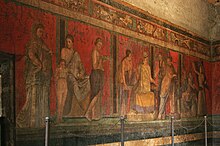
Roman Republican art is the artistic production that took place in Roman territory during the period of the Republic, conventionally from 509 BC to 27 BC.
The military, political and economic development of the Roman Republic did not coincide with the development of an autonomous artistic civilization. In the Republican period at least three artistic moments can be distinguished: the first as a continuation of archaic culture, where production in the city did not manifest any stylistic characteristic of its own; a second linked to the conquest of Greece and the arrival of huge spoils of works of art; and a third phase starting during the reign of Sulla, when specifically Roman artworks began to appear.
Beginnings of artistry
509 BC traditionally marks the expulsion of the
Religious activity in Rome at that time was intense and many temples were constructed. Each had its own statues, mostly bronze, which decorated the city. Some references on the coins and on contemporary finds of Tarquinia, Chiusi, Perugia, and Volterra allow us to make hypotheses on the appearance of these statues. They represented practical art placed for the purposes of storytelling or modest decoration.
This scarcity of artistic interest is well justified by the framework of the Roman mentality, intended as an expression of a population used to fighting against nature, poverty and neighboring populations. The Roman patrician was typically a tough, violent and tenacious man, forged by fatigue, having practical and immediate interests. They generally disregarded anything that did not bring immediate utility. In the second century BC, for example, the Senate arranged for the demolition of a newly constructed stone theater "as a useless and harmful thing to our customs".[1]
A unique example of sculpture of superior production and craftsmanship is the Capitoline Brutus, the object of numerous dating hypotheses ranging from the 4th to the 1st century BC. The strong, expressive composition distances it from Greek and Etruscan art, indicating an evolution of Italian style.[2]
Spoils of war
Haec ego, quo melior laetiorque in dies fortuna rei publicae est, [...] eo plus horreo, ne illae magis res nos ceperint quam nos illas. Infesta, mihi credite, signa ab Syracusis inlata sunt hunc urbi. Iam nimis multos audio Corinthi et Athenarum ornamenta laudantes mirantesque et antefixa fictilia deorum Romanorum ridentes. Ego hos malo propitios deos et ita spero futuros, si in suis manere sedibus patiemur.[3] |
This information, brighter and better the experience is [...] the more I fear that these things will capture us and we them. Danger, believe me, they are the signs of this were brought from Syracuse city. They are too many people praising and admiring those which adorn Athens and Corinth and of earth; I hear the gods, Roman gods. I prefer that these gods who are propitious, and I trust that they will be if we remain in their present abodes. |
| — Ab Urbe Condita Libri liber XXXIV |
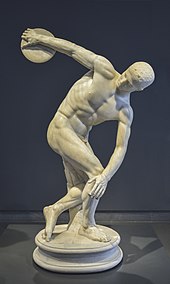
In 280 BC, the army of Pyrrhus of Epirus clashed with the Romans in Italy, the first large direct contact between Romans and Greek people. This was followed in 272 BC by the capture of Taranto, the capture of Reggio in 270 BC, and the league with Syracuse during the first Punic war (264 - 241 BC). The admission of the Romans to the Isthmian Games in 228 BC was equivalent to the entry of Rome into Greek civilization.
The capture of Syracuse in 212 BC was decisive, following which Marcus Claudius Marcellus brought back a huge number of Greek works of art to Rome. This marked a turning point in Roman culture and artistic practice. Even then there were those who reproached Marcellus "for having filled with idleness and chatter and for having led to urban discussion of art and artists [...] those people accustomed to fighting and cultivating the fields, avoiding any softness and frivolity.".[4]
Subsequently, after the
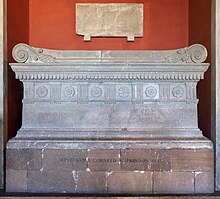
In less than a century, Rome was home to a large group of wealthy art collectors. They themselves, as Cicero testifies in the Verrine, had a certain modesty in publicly confessing their appreciation for art, knowing that society viewed it negatively. Many frowned upon the implied superiority of Greek culture. The controversy on the subject focused on contrasting positions of the Scipionic Circle, open to Hellenic cultural suggestions, and the conservatism of Cato and his followers.
After the victory against
The first white marble buildings in Rome were two small constructions, a somewhat "shy" debut: the
Copying works
After the populated circle of passionate art collectors had formed, the Greek originals were no longer sufficient to meet the demand. A mass copy trade was started. Statues and paintings inspired by classical pieces were imported from the Neo-Attic workshops in Athens.
Eclecticism
 |
Thiasos |
Naturally, after the huge influx of foreign art in Rome, coming from different schools and referring to very different periods, a certain amount of time was needed to assimilate and begin to understand these artistic legacies. As Romans attempted to interpret this foreign art, they developed distinctly eclectic characteristics. Early Roman originals saw the presence of contrasting styles within the same work, influenced by several different cultures simultaneously. This is apparent in the Altar of Domitius Ahenobarbus and Ara Pacis.
Plebeian art
This section is empty. You can help by adding to it. (March 2020) |
Triumphal painting
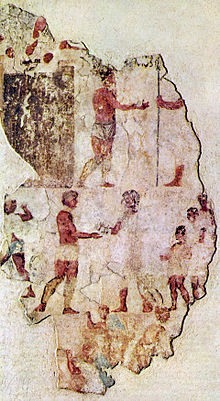
At the end of the fourth century, a painter Fabius Pictor was active in the decoration of the Temple of Salus in 304 BC. Painting at that time had a mainly practical, ornamental and, above all, celebratory purpose. It has been hypothesized that Fabius' decoration was of a narrative and historical nature, and that Republican painting with scenes from the Samnite Wars in the Esquiline Necropolis could be derived from these works.
From the third century BC, there is documentation of "triumphal" paintings, that is, paintings brought to the triumph parades with the narratives of events of the victorious military campaign or the appearance of the conquered cities. Triumphal painting was influential on Roman historical reliefs.
Age of Sulla and Caesar
From 130 BC, through the dictatorship of Sulla, and up to the first consulate of
In these years sees the birth of clearly identifiable Roman artistic culture. When contact with art became usual for a Roman citizen, the new "Roman" artistic identity with its own characteristics began to develop.
After Sulla rose to power in 92 BC, Rome saw the most remarkable innovations in architecture, wall painting, and in the formation of realistic portraiture.
Architecture
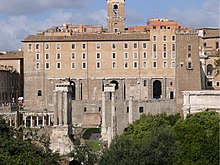
During the reign of Sulla, the traditional wooden structures with Etruscan terracotta cladding or stuccoed tuff gave way to buildings built of travertine or other limestone. This was influenced by Hellenistic architecture, but adapted to a simpler, more modest form. The architectural elements had been raised from strictly pragmatic, allowing a decorative use that gave great freedom to architects.
At the time of the
After the fire of 83 BC, the
After Caesar rose to power, there was the creation of his great Forum of Caesar and the Temple of Venus Genetrix.
Portraiture
Roman Republican portraiture is characterized by
Portraiture in Republican Rome was a way of establishing societal legitimacy and achieving status through one's family and background. Exploits wrought by one's ancestors earned them and their families public approbation, and more; a pompous state funeral paid for by the state. Wax masks would be cast from the family member while they were still living, which made for hyper-realistic visual representations of the individual literally lifted from their face. These masks would be kept in the houses of male descendants in memory of the ancestors once they had passed. These masks served as a sort of family track record, and could get the descendants positions and perks,[6] similar to a child of two alumni attending their alma mater.
Republican Rome embraced imperfection in portraiture because, though there were different levels of power each class of society had, everybody had little insecurities, this type of untouched physical representation fostered a sense of community by implying that while there were existing inequalities, that did not change the fact that they were Romans.
-
The Orator, c. 100 BC, an Etrusco-Roman bronze statue depicting Aule Metele (Latin: Aulus Metellus), an Etruscan man wearing a Roman toga while engaged in rhetoric; the statue features an inscription in the Etruscan alphabet
-
Isis priest, bronze bust, mid 1st century BC
-
The Grave relief of Publius Aiedius and Aiedia, 30 BC, Pergamon Museum (Berlin)
-
The Patrician Torlonia bust depicting Cato the Elder, 1st century BC
-
The Osimo head, 1st century BC
-
Veristic portrait bust of an old man, head covered (paterfamilias(marble, mid-1st century BC)
-
Head of an old Roman, c. 60 BC. The realistic rendering of old age (baldness, face and neck wrinkles) corresponds to the esthetic ideal of the end Republic.
-
A funerary relief with members of the gens Vibia, late 1st century BC.
-
A Roman marble bust of
-
The Tusculum portrait of Julius Caesar, 50–40 BC
Painting
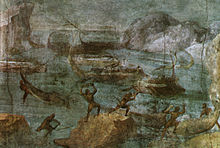
This period is defined by a Roman painting style called Pompeian, named such due to the studies of the conspicuous finds of Pompeii.
Along with the sculptures, numerous Greek paintings had arrived in Italy. Many painters had moved to Rome from
It was typical for a stately home to have every corner of the wall painted, with extraordinary quantity of pictorial decorations. These works, however, were not the result of the Roman inventiveness, but were a last remnant of purely Greek artistry.
Among the most interesting examples of the time there are the frescoes with scenes of the Odyssey from the Via Graziosa house, dating from 50 to 40 BC. These were most likely copies made (with some errors, as in the Greek names of the characters) of an Alexandrian original dating from around 150 BC.
Mosaic

The first evidence of mosaic tiles in Rome dates back to the end of the third century BC. Mosaic art was used practically as a means to waterproof the clay floors and make it more resistant to trampling. Eventually, cultural exchanges with Greece and Egypt changed the aesthetics and compositions developed. Greek workers brought classic mosaic motifs, including doves and scenes from the Nile.
The wall mosaic was born at the end of the Republic, towards the first century BC. In Pompeii and Herculaneum, mosaics were used to waterproof exedras, as they were often decorated with fountains.
One of the most notable examples of mosaic from this period is the Nile mosaic of Palestrina. It is an accurate depiction of the course of the Nile, with scenes of hunting, fishing, rituals and banquets.
Notable artists
The list of notable Roman artists from the period includes:
- Alexander, metalworker
- Arellius, painter
- Argelius, architect
- Cyrus, architect
- Iaia, painter
- Gaius Fabius Pictor, painter
- Hermodorus of Salamis, architect
- Pacuvius, painter
Notes
- Ab Urbe Condita Libri48.
- ^ Ranuccio Bianchi Bandinelli and Mario Torelli. cit., page 70.
- ^ Livius, Titus. Ab Urbe Condita Libri. p. 4.
- ^ Plutarch, Marcello, 21
- ^ Pliny the Elder Naturalis Historia XXXIV, 34.
- ^ Pollini, John. "Ritualizing Death". From Republic to Empire Rhetoric, Religion, and Power in the Visual Culture of Ancient Rome. pp. 13, 19.
- ^ Raia, Ann R.; Sebesta, Judith Lynn. (September 2017). "The World of State". College of New Rochelle. Accessed 6 March 2018.
- ^ "Cat. 22 Tetradrachm Portraying Queen Cleopatra VII". Art Institute of Chicago. Accessed 6 March 2018.
- ^ Grout, James. (April 1, 2017). "Was Cleopatra Beautiful?". Encyclopaedia Romana. University of Chicago. Accessed 6 March 2018.
Bibliography
- (in Italian) Ranuccio Bianchi Bandinelli & Mario Torelli, L'arte dell'antichità classica, Etruria-Roma, Utet, Torino 1976.
- (in Italian) Pierluigi De Vecchi & Elda Cerchiari, I tempi dell'arte, volume 1, Bompiani, Milano 1999
You can help expand this article with text translated from the corresponding article in Italian. (December 2008) Click [show] for important translation instructions.
|









![A Roman marble bust of Cleopatra VII of Ptolemaic Egypt, c. 50-30 BC (around the time of her visit to Rome with Julius Caesar)[7][8][9]](http://upload.wikimedia.org/wikipedia/commons/thumb/7/75/-0035_Altes_Museum_Portrait_Kleopatra_VII_anagoria.JPG/68px--0035_Altes_Museum_Portrait_Kleopatra_VII_anagoria.JPG)
